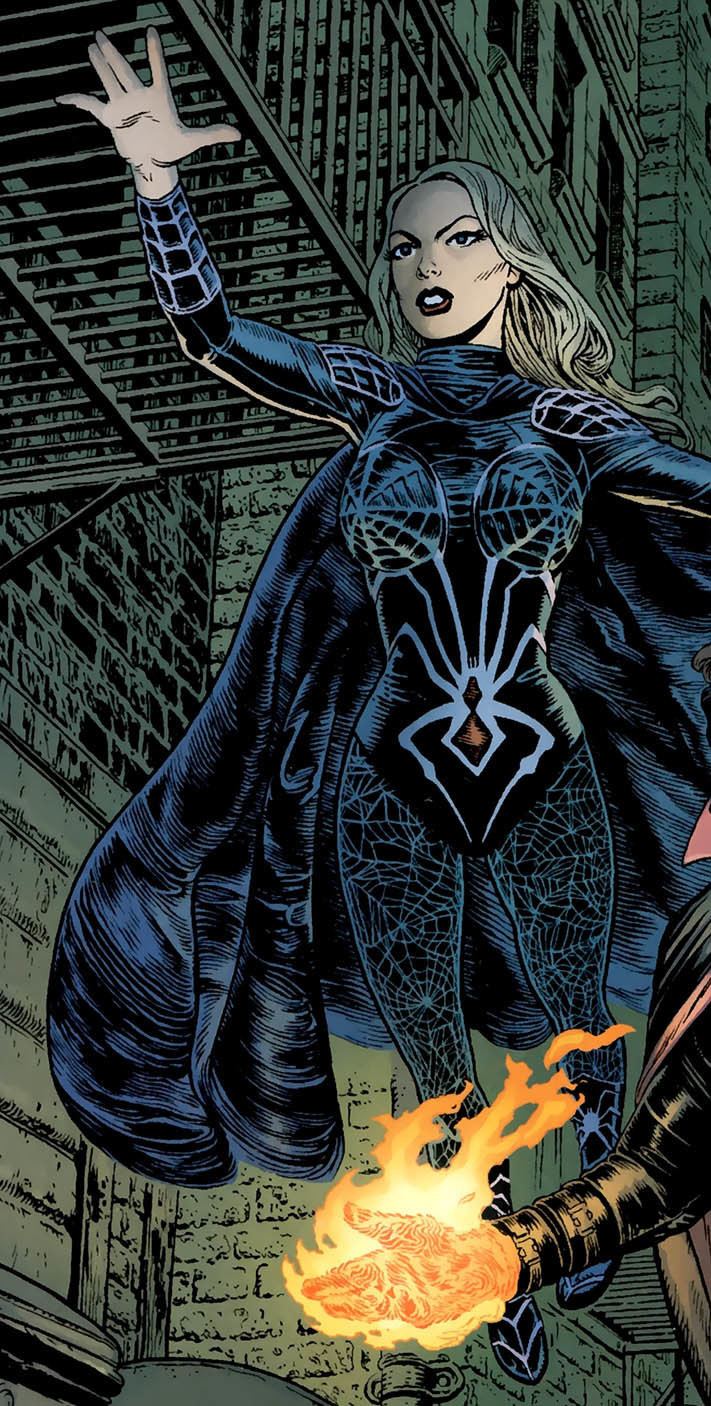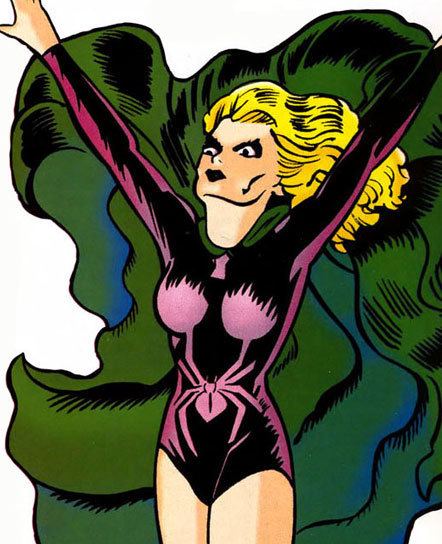Alter ego Claire Voyant | ||
 | ||
Abilities Superhuman strengthEnhanced enduranceFlightTeleportationMental suggestionInvisibilityAppearance alterationDeath touchImmortalityAbility to communicate with the dead and mystically regenerate or heal others Similar Dynamic Man, Laughing Mask, American Ace, Blue Diamond, Destroyer | ||
Black Widow (Claire Voyant) is a fictional character appearing in American comic books published by Marvel Comics. An antiheroine who kills evildoers in order to deliver their souls to Satan, her master, she first appears in Mystic Comics #4 (cover dated Aug. 1940), published by Marvel predecessor Timely Comics. Created by writer George Kapitan and artist Harry Sahle, she is unrelated to Marvel's later superspy character called Black Widow.
Contents
- Publication history
- Fictional character biography
- Modern incarnation
- Personality
- Costume
- Historical significance
- Powers and abilities
- References

Publication history

The Black Widow makes five appearances during the period fans and historians call the Golden Age of comic books, all five written by George Kapitan. These short comics stories (the longest is eight pages, the shortest five) are spread among three different Timely anthology titles over a three-year period from 1940 to 1943.

Madame Claire Voyant is introduced in Mystic Comics #4 as "the strangest, most terrifying character in action picture magazines — the Black Widow. You've heard of the black widow spider — that evil creature whose bite spells doom. Now start the adventures of another black widow — a human tool of Satan whose very touch means death." Both Mystic Comics #4 and #5 (Aug. 1940, Mar. 1941) feature artwork by Harry Sahle (the stories are "Introducing the Black Widow", 7 pages, and "Garvey Lang", 8 pages, respectively). Another Mystic Comics appearance in issue #7 (Dec. 1941) has art by Stan Drake ("Lewis & Sykes", 5 pages). USA Comics #5 (Summer 1942) is penciled by Mike Sekowsky and inked by George Klein ("Murder Unlimited", 5 pages). Her final Golden Age appearance in All Select Comics #1 (Fall 1943) has art tentatively attributed to Drake ("Blood Money", 5 pages); this story is reprinted in 1974, along with the rest of the issue, by publisher Alan L. Light's company Flashback as Special Edition Reprints #14.

Her next appearance occurs 51 years later, in a flashback cameo in one panel of issue #1 (Jan. 1994) of the mini-series Marvels ("A Time of Marvels", written by Kurt Busiek with art by Alex Ross), and again nine years later (Feb. 2005), also in brief flashback, in Marvel Knights Spider-Man #9 ("The Last Stand", written by Mark Millar with art by Terry and Rachel Dodson).

The Black Widow returns, finally in full-length stories, albeit as part of an ensemble cast, beginning in 2008 in The Twelve (written by J. Michael Straczynski with art by Chris Weston). The character appeared in all 12 issues of The Twelve, in addition to a one-shot titled The Twelve: Spearhead.
Fictional character biography

In 1940, Claire Voyant is a spirit medium who communicates with the dead through supernatural means. While serving a family named the Waglers, she is possessed by Satan to put a curse on them. James, a member of that family, survives a subsequent car crash provoked by the spell and, upon returning to Claire's quarters, guns her down.
Voyant's soul goes to Hell, where Satan dresses her in her Black Widow costume. He also gives her the power to kill with a single touch of her fingers to the head (which leaves a branded "Black Widow mark") and other mystical tricks. Satan (who, daringly for the time, is discreetly depicted as a nearly nude man) sends her back to Earth to avenge her death. After killing her murderer, she returns to Satan who, no longer content to wait for evil souls to die a natural death and perhaps repent their sins in the interim, charges her with bringing those souls to him. "On the upper world are mortal creatures whose hearts are blackened with wickedness and corruption. You, the Black Widow, will bring their evil souls to me!"
She later kills corrupt arms manufacturers, crime boss Garvey Lang, members of a syndicate called Murder Unlimited and the villain Ogor, while also healing Ogor's victim.
In Marvels, she is shown in flashback as part of a group of Timely's Golden Age characters aiding the Invaders against the Nazis.
Modern incarnation
In The Twelve, Claire Voyant is retconned as becoming the Black Widow in 1928 after her sister is murdered. Standing over her sister's grave, she wishes for the power to avenge herself against the killer, and Satan responds.
Revived in the present day, along with 11 other heroes, after being in suspended animation since World War II, she recommences serving as an "instrument of vengeance" for an initially unidentified entity (though never actually referred to as Satan, the Black Widow's master is identified as "the devil" in later issues) and going on missions for that party.
Personality
A recurrent character trait of the Black Widow in her Golden Age appearances is that she shows no hesitation or mercy when it comes to killing her victims, and no apparent remorse over depriving them of their lives and sending their souls to Hell for eternal torment. Whether this ruthless aspect of her personality is original to Claire Voyant or a result of her resurrection by Satan as the Black Widow is unclear. (In her modern day appearances in The Twelve she is much less a willing killer, and is shown crying after killing.)
In Golden Age appearances she does possess great compassion for those she perceives as innocent victims of evil, and a willingness to use her powers to protect and even heal them. This is shown most clearly in her fifth and last Golden Age appearance when she is sent by Satan to harvest the soul of Ogor, a charlatan faith healer who has been stealing money from those who come to him for cures. After confronting Ogor and causing his death – though he instantly dies of fright and heart failure rather than the Black Widow’s signature death touch, the result is the same, his blackened soul goes instantly to Hell – she then takes the time, and uses her powers, to regenerate the amputated leg of a young boy named Pepito, one of Ogor’s last victims he had promised to heal.
Costume
During her five brief appearances in the Golden Age, the Black Widow wears four distinctly different costumes, with different designs and different color schemes, and has three different hair colors.
Appearing only in Mystic Comics #4, her first costume consists of a purple bodysuit with spider design on the belly, a green-and-blue striped cape, and red boots with yellow flame designs around the tops.
For her second appearance in Mystic Comics #5, the red boots with yellow flame trim survive; however, the bodysuit becomes plain black with no spider design, and the color of her cape changes to solid red.
In Mystic Comics #7 the color scheme and basic layout of the costume remain the same; however, the bodysuit acquires dark blue highlights, and the red cape now has flame designs around its hem. Both the "flames" and the cape itself are the same shade of red. Though highly similar to the costume in Mystic Comics #5, it is different in its particulars. The cape is held in place with a circular, gold-colored pin inset with a death’s head skull. Her hair remains blond for all three Mystic Comics appearances.
In USA Comics #5, the costume changes radically. The outfit's colors are now red, white and blue. The costume itself consists of a bright red bodysuit, a cape (colored either white or blue depending on the panel in question) with upturned Peter Pan collar, and white buccaneer boots. Her hair is now pure white.
For her final Golden Age appearance, in All Select Comics #1, the costume morphs into a blue bodysuit that, unlike any of her previous outfits, covers her legs as well as torso and arms, and a yellow cape. The boots with flame trim return, however both the boots and "flames" are yellow. The Black Widow is now a redhead.
Throughout the majority of The Twelve she wears a fifth outfit, a minor redesign of the first, consisting of a dark purple bodysuit with, in a lighter shade of purple, a spider design on the belly. Her boots are the same dark purple as the bodysuit, with no "flames"; the cape is light purple, and likewise has no flame trim. In issue #12, the finale, she wears a sixth costume, which is gray, that covers her entire body except her head and hands, and features a fine spiderweb pattern over much of its surface.
Historical significance
Introduced in Mystic Comics #4 (Aug. 1940), the Black Widow is comic books' first costumed, superpowered female character. While writer-artist Fletcher Hanks' Fantomah, who has the superhero tropes of a dual identity and superpowers, debuted earlier, in Fiction House's Jungle Comics #1 (Feb. 1940), she lacks a distinctive costume. While The Woman In Red also predates her, debuting in Standard Comics' Thrilling Comics #2 (March 1940), that character has a distinctive costume but no superpowers. Russell Stamm's Invisible Scarlet O'Neil, a non-costumed character with the superpower of invisibility, debuted in a newspaper comic strip, rather than a comic book, on June 3, 1940.
Powers and abilities
Before her transformation into the Black Widow, Claire Voyant has undefined psychic powers enabling her to communicate with the spirits of the dead. Resurrected by Satan after her murder, the Black Widow has been granted supernatural powers allowing her to harvest the souls of evildoers for her master. She is able to teleport between Hell and the mortal world. Having already died, she is apparently immune to further attempts to kill her. In three separate Golden Age appearances, she is shot repeatedly and the bullets have no effect. She can mentally plant suggestions in the minds of others, possesses superhuman strength of an undefined nature, enhanced endurance, flight, invisibility, appearance alteration, and the ability to regenerate or heal others mystically.
She also has a death touch power. When the Black Widow touches one of her victims on the forehead, there is a burst of flame, they are instantly struck dead and their soul is sent to Hell. At the same time a mark is left in the shape of a spider.
In her modern appearances in The Twelve, she exhibits the ability to fly and superhuman strength sufficient to rip human bodies to pieces. Apparently she still possesses her death touch power, however the only time she is shown attempting its use, it fails to work on a non-human target.
Satan claims he has made her immortal. Within the context of The Twelve when Claire Voyant becomes the Black Widow in 1928 she appears to be in her mid-20s. When she goes into suspended animation, 17 years later, in 1945, she apparently has not aged at all. In this case, it seems that the Prince of Lies may have told the truth.
